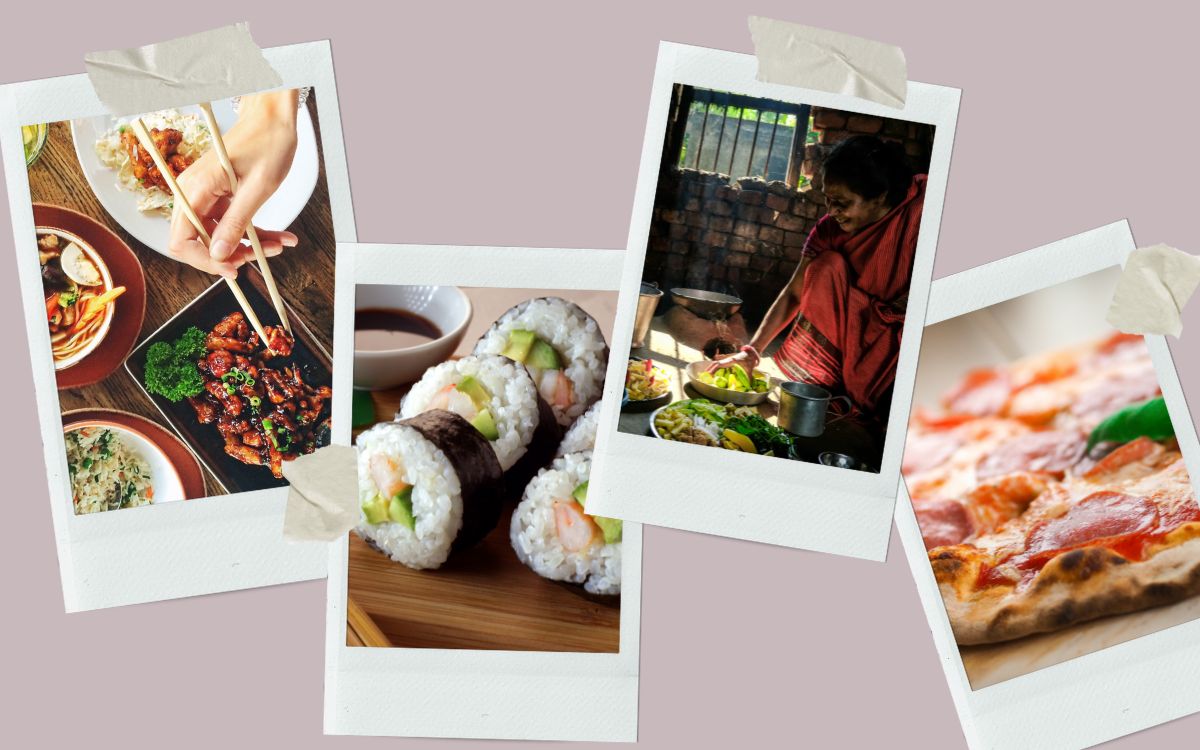Food is not only a means of sustenance but also a reflection of cultural identity and a gateway to understanding diverse traditions. In this blog post, we will embark on a culinary adventure, exploring fascinating dining rituals, peculiar table manners, and exotic delicacies from various corners of the globe.

By delving into these unique customs, we can gain a deeper appreciation for the richness and diversity of global gastronomy. So, let’s open our minds and palates as we uncover the intriguing world of unusual food customs and etiquette around the globe.
Dining Traditions in Asia
Asia, a continent known for its rich cultural heritage, has a plethora of unique dining traditions that have been passed down through generations. From the intricate art of using chopsticks to the harmonious balance of flavors in traditional dishes, Asian dining customs offer a captivating glimpse into the region’s culinary world. Let’s delve into some of the fascinating dining traditions in countries like China, Japan, and India.
China: A World of Chopsticks and Family-Style Dining
In China, dining is a communal experience that emphasizes the importance of family and togetherness. One prominent feature of Chinese dining is the use of chopsticks, which requires skill and dexterity. It is considered impolite to leave chopsticks sticking upright in a bowl of rice, as it resembles incense used in funeral rituals.
Family-style dining is prevalent, where dishes are placed in the center of the table, and everyone shares from the communal plates. This fosters a sense of unity and creates an opportunity for lively conversations and bonding.
Japan: Mastering the Art of Sushi and Tea Ceremonies
Japanese dining traditions are deeply rooted in precision, simplicity, and respect for nature. The art of sushi making is revered, with meticulous attention paid to the freshness of ingredients and the delicate balance of flavors. In addition to sushi, the Japanese also embrace the tea ceremony, a highly choreographed ritual that embodies tranquility and hospitality. Participants are guided through the process of preparing and serving tea, symbolizing harmony and mindfulness.
India: Eating with Your Hands and the Concept of Sharing Meals
In India, eating with your hands is a common practice that dates back centuries. The belief is that eating with the hands enhances the sensory experience and connects the individual to the food on a deeper level. However, there are specific rules and customs associated with this practice, such as using only the right hand and avoiding direct contact between the fingertips and the mouth.
Another intriguing aspect of Indian dining is the concept of sharing meals. Traditional thali meals consist of a variety of dishes served on a large metal tray, allowing individuals to savor a diverse range of flavors in a communal setting.
European Gastronomic Traditions
Europe, renowned for its diverse culinary heritage, boasts a myriad of gastronomic traditions that have captivated palates around the world. From the refined elegance of French cuisine to the hearty indulgence of Italian fare, European dining customs offer a delightful exploration of flavors, techniques, and cultural nuances. Let’s dive into some of the captivating gastronomic traditions found in countries like France, Italy, and Spain.
France: Savoring Long Meals and the Art of Wine Pairing
French dining traditions are synonymous with sophistication and culinary excellence. The French take immense pride in their culinary heritage, and meals are viewed as a leisurely affair to be savored. From the apéritif to the digestif, each course is carefully curated to create a harmonious progression of flavors.
The art of wine pairing is highly regarded, with specific wines selected to complement the different dishes. Furthermore, French dining etiquette places importance on proper table manners and decorum, adding an element of elegance to the overall experience.
Italian cuisine is cherished worldwide for its simplicity and bold flavors. When it comes to dining in Italy, there are a few customs worth noting. Firstly, pasta is never eaten with a spoon but rather twirled onto a fork. Cutting pasta with a knife is considered a faux pas.
Additionally, folding pizza slices or using utensils to eat pizza is uncommon; instead, Italians prefer to eat pizza with their hands. Meals are often leisurely and social affairs, with friends and family gathering to enjoy hearty, multi-course meals that celebrate the abundance of local produce and culinary traditions.
Spain: Embracing Tapas Culture and Social Dining
In Spain, dining is more than just nourishment; it is an opportunity for connection and celebration. Tapas, small plates of savory bites, are a central feature of Spanish dining culture. Spaniards relish the tradition of sharing tapas with friends while sipping on wine or enjoying a refreshing glass of sangria.
The concept of a siesta, a midday break for rest and relaxation, is also deeply ingrained in Spanish culture, allowing time for a leisurely lunch with colleagues or family members. This communal and convivial approach to dining reflects the warmth and hospitality for which Spain is renowned.
African Culinary Customs
Africa, a continent teeming with diverse cultures and vibrant traditions, boasts a captivating culinary landscape that is as rich and varied as its people. From the flavorsome spices of North Africa to the communal feasts in Ethiopia, African culinary customs offer a fascinating exploration of heritage, community, and the celebration of food. Let’s embark on a journey to discover some of the remarkable culinary traditions found in regions such as Ethiopia, Morocco, and South Africa.
Ethiopia: The Tradition of Injera and Communal Eating
In Ethiopia, dining is a communal affair that brings people together in celebration. A prominent feature of Ethiopian cuisine is injera, a sourdough flatbread that serves as both a staple and utensil. Traditionally, injera is placed on a large platter, and various stews, known as wats, are served on top.
Injera acts as a vessel for scooping up the delicious flavors, fostering a sense of togetherness as everyone eats from the same platter. This communal dining experience represents the importance of unity and sharing in Ethiopian culture.
Morocco: Enjoying the Flavors of a Traditional Moroccan Feast
Moroccan cuisine is renowned for its bold spices, aromatic flavors, and the art of slow-cooking. In Moroccan culinary traditions, the gathering of loved ones to enjoy a traditional feast is a cherished custom. A typical Moroccan meal begins with a series of small appetizers, known as meze, followed by the main course.
The centerpiece of a Moroccan feast is often a tagine, a slow-cooked stew of meat or vegetables with a blend of spices, such as cumin, coriander, and saffron. The meal is typically enjoyed with hands, as bread is used to scoop up the delicious morsels, fostering a sense of conviviality and connection.
South Africa: The Tradition of a Braai and the Importance of Sharing
In South Africa, the braai (barbecue) holds a special place in the hearts of its people. The braai is more than just a cooking method; it is a social gathering where friends and family come together to enjoy grilled meats, vibrant salads, and lively conversations.
The art of braaiing is not limited to specific occasions but is a way of life for many South Africans. It represents a sense of community, hospitality, and the joy of sharing good food. The aromas of sizzling meats and the warmth of the fire create an atmosphere that is truly unique to South African culinary customs.
Indigenous Food Traditions
Indigenous food traditions are a testament to the deep connection between communities and the natural world. Passed down through generations, these culinary customs reflect a profound respect for the land, an appreciation for sustainable practices, and a celebration of cultural heritage. Let’s explore the intriguing food traditions of indigenous cultures, including the Maori of New Zealand, the Inuit of Arctic regions, and the Native Americans of North America.
Maori (New Zealand): The Significance of a Hangi and Cultural Protocols
The Maori people of New Zealand have a rich food culture rooted in their deep spiritual connection to the land. One of their traditional culinary practices is the hangi, a method of cooking food using heated rocks buried in an earth oven.
The hangi represents not only a method of preparing delicious food but also a way of honoring ancestral traditions and the connection to Papatūānuku (Mother Earth). The process of gathering ingredients, preparing the hangi pit, and the protocols associated with sharing and consuming the food are all significant aspects of Maori food customs.
The Inuit people of the Arctic regions have developed unique food customs adapted to their harsh and icy surroundings. Due to the scarcity of vegetation, the Inuit traditionally relied on hunting marine mammals and fish for sustenance. In their culinary customs, the use of utensils is intriguing.
In the past, the Inuit utilized tools made from bone, antler, or ivory to extract and consume their food. The use of hands and fingers was also common, allowing for maximum efficiency in an environment where extreme cold temperatures made the handling of utensils challenging.
Native American (North America): Rituals and Spiritual Aspects of Traditional Feasts
The Native American tribes of North America have a deep-rooted connection to the land, and their food customs are steeped in spirituality and tradition. Traditional feasts, often centered around seasonal harvests or significant cultural events, hold great importance.
These feasts are not merely about nourishment but also serve as rituals to express gratitude, seek blessings, and foster unity within the community. Each tribe has its own customs and ceremonial practices, including the preparation of specific traditional dishes, storytelling, and communal participation.
Unconventional Delicacies and Taboos
Food customs around the world can vary greatly, and some cultures embrace unconventional delicacies that may challenge the palates and perceptions of outsiders. From unique ingredients to cultural taboos, these culinary practices offer a fascinating glimpse into the diverse range of human experiences. Let’s explore some of the unconventional delicacies and taboos found in different parts of the world.
Delicacies
Insects as Delicacies
In several cultures, insects are considered delicacies and are incorporated into traditional cuisine. For example, in parts of Southeast Asia, fried crickets and mealworms are popular snacks, prized for their crunchy texture and nutritional value.
Similarly, in Mexico, chapulines (grasshoppers) are enjoyed as a flavorful topping for tacos. These unconventional delicacies highlight the resourcefulness and sustainability of utilizing insects as a protein source.
Fugu: The Potentially Deadly Delicacy
Fugu, a pufferfish delicacy in Japan, is notorious for its potentially lethal toxicity. Skilled chefs meticulously remove the poisonous parts of the fish, leaving only the edible portions. Consuming fugu requires precise preparation to ensure the removal of the deadly tetrodotoxin. Its consumption is not only an indulgence in flavors but also a testament to the chef’s expertise and the diner’s trust.
Taboos
Dietary Restrictions
Various cultures have dietary taboos rooted in religious, cultural, or health-related beliefs. For instance, Hindus refrain from eating beef due to the sacred status of cows. In Islamic culture, pork is considered haram (forbidden) and is avoided by practicing Muslims. These taboos highlight the significance of religious and cultural practices in shaping dietary choices and reinforcing community bonds.
Food Pairing Taboos
Some cultures have specific taboos regarding food pairings. For example, in Thai cuisine, combining sweet and savory flavors in the same dish is generally avoided. Similarly, in traditional Chinese medicine, the concept of yin and yang influences food pairing, discouraging the combination of certain ingredients believed to disrupt the body’s balance. These taboos demonstrate the cultural importance of achieving harmony and balance in culinary practices.
Cultural Sensitivities
What may be a delicacy in one culture could be considered taboo or offensive in another. For instance, the consumption of dog meat is common in some Asian countries but is met with strong cultural opposition in many Western societies where dogs are considered companion animals. Cultural sensitivities play a significant role in determining what is deemed acceptable or taboo in the realm of food.
Conclusion
As we come to the end of our exploration, we have discovered a tapestry of culinary traditions and dining etiquettes that truly showcase the beauty of cultural diversity. From the elegant tea ceremonies of Japan to the communal feasts in Ethiopia, every custom carries a significance that extends far beyond the act of eating. It is through understanding and respecting these customs that we can bridge cultural gaps, foster connections, and cultivate a global appreciation for the importance of food in our lives.









